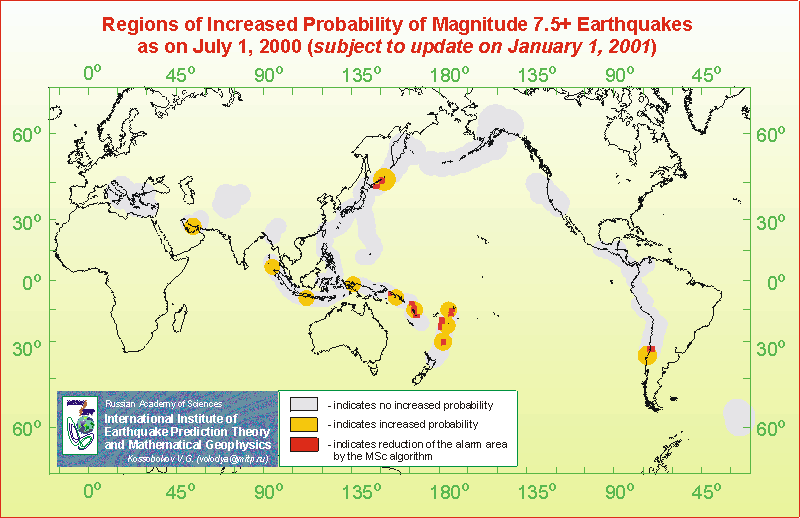
According to the to the USGS/NEIC QUICK EPICENTER DETERMINATIONS (Golden, CO - NO. 1-014 JAN 14, 2001) the following earthquakes of magnitude 7.5 or more happened in July-December 2000.
|
Date and Time
|
Lat Lon Depth
|
Magnitudes (mb, MS, other)
|
|
2000/11/16 04:54
|
-3.958 152.268 33
|
5.8 8.1 8.00MWHRV 8.00MEGS
|
|
2000/11/16 07:42
|
-5.179 153.054 33
|
6.2 7.8 7.60MWHRV 7.30MEGS
|
|
2000/11/17 21:01
|
-5.453 151.685 33
|
6.2 8.0 7.60MWGS 6.90MEGS
|
|
2000/12/06 17:11
|
39.625 54.772 30
|
6.6 7.5 7.00MWGS 6.90MEGS
|
The last one in TURKMENISTAN (where the background seismic rate is insufficient to run the M8 algorithm in the original version) is outside our test area. The other three are a cluster of earthquakes from NEW IRELAND and NEW BRITAIN REGIONS, P.N.G.
None of them are predicted.
According to QED all the three are "complex events" of which the largest two are clear outliers of the activated aftershock zone.
I was surprised to find that their station magnitudes scale with the epicentral
distance: The larger is the distance to the station - the larger is its MS!
Here are the two MS averages estimated over the stations from epicentral and
antipodal hemispheres (data from the USGS/NEIC mchedrqed.dat file as on JAN
14, 2001 was used) for each of the earthquakes:
|
Date and Time
|
Epicentral hemisphere
|
Antipodal hemisphere
|
||
|
Average MS
|
Number
|
Average MS
|
Number
|
|
|
2000/11/16 04:54
|
7.6
|
16
|
8.1
|
37
|
|
2000/11/16 07:42
|
7.5
|
27
|
7.8
|
60
|
|
2000/11/17 21:01
|
7.4
|
17
|
8.0
|
53
|
|
2000/12/06 17:11
|
7.2
|
28
|
7.5
|
58
|
The enlarged Figure shows the M8-MSc alarms issued
for the second half of 2000 for M8.0+ and M7.5+ along with the epicenters of
Nov 16 and 17 earthquakes and their aftershocks. The M7.5+ prediction misses
the earthquakes by 200 km (which is less than the distance between centers of
neighbor circles of investigation).